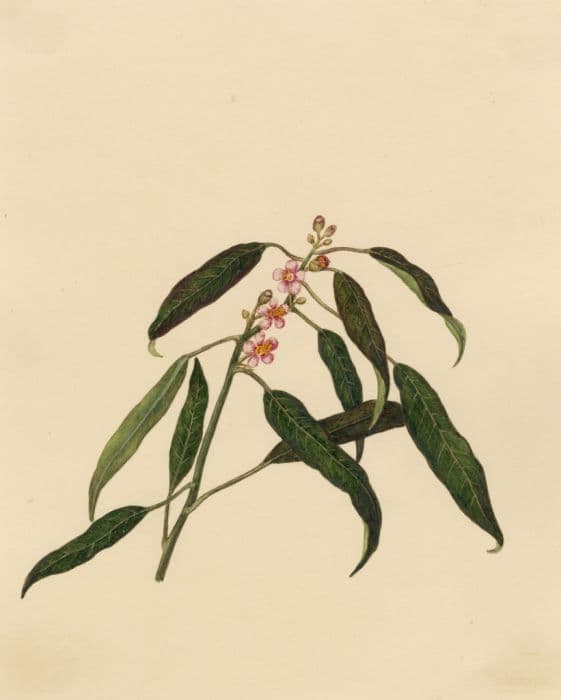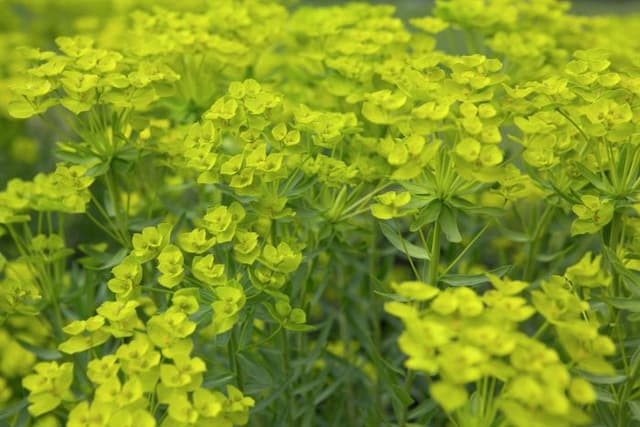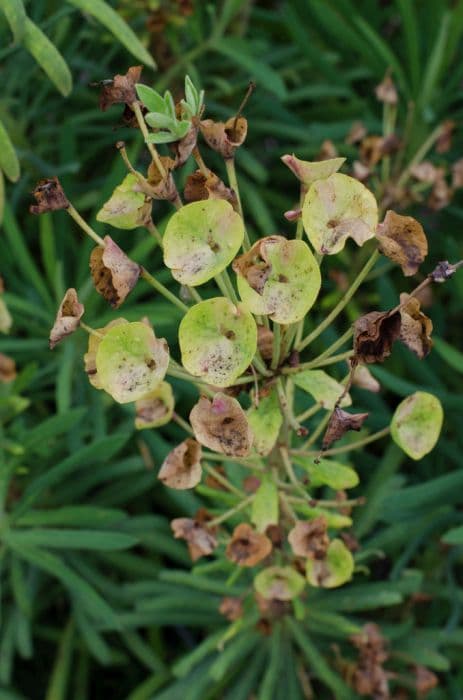Scarlet Plume Euphorbia fulgens

ABOUT
The plant commonly known as Scarlet Plume is a visually appealing specimen, renowned for its brilliant display of vividly colored bracts which can range from fiery red to an orange hue. These bracts are often mistaken for flowers, due to their striking color and prominence, but they actually serve to attract attention to the small, central flowers which are relatively inconspicuous. The true flowers are tiny and clustered within these colorful bracts. The Scarlet Plume has an upright growing habit, with multiple branches creating a somewhat sprawling shape. The leaves of the plant are slender, elongated, and come to a point at the tip. They're a dark, glossy green that contrasts nicely with the red bracts. As the plant matures, it can become more woody and the stems may take on a tree-like appearance. Since we are to eliminate references to size, we will not mention its dimensions but focus on its general characteristics. Throughout its growing season, the Scarlet Plume produces its colorful bracts and flowers which can last for several weeks, making it a popular choice for ornamental purposes. The bracts add significant visual interest to the plant and make it a standout in any garden display.
About this plant
 Names
NamesFamily
Euphorbiaceae.
Synonyms
Scarlet Plume, Winter Euphorbia.
Common names
Euphorbia fulgens var. fulgens.
 Toxicity
ToxicityTo humans
Scarlet Plume (Euphorbia fulgens) is considered toxic due to its latex-like sap, which contains skin-irritating and toxic compounds. If ingested, the sap can cause symptoms such as burning pain in the mouth and throat, vomiting, diarrhea, and stomach pain. Contact with skin may lead to irritation, redness, and swelling, and if the sap comes into contact with the eyes, it can cause severe pain and possibly temporary blindness. It is important to handle this plant with care and to keep it out of reach of children.
To pets
Scarlet Plume (Euphorbia fulgens) is toxic to pets due to its latex-like sap. The sap contains irritant compounds that can be harmful if ingested. Symptoms of poisoning in pets may include vomiting, diarrhea, drooling, pawing at the mouth, and signs of oral irritation. If the sap comes into contact with the pet's skin or eyes, it can lead to irritation, redness, swelling, and pain. It is crucial to prevent pets from chewing on or ingesting any part of the plant to avoid these harmful effects.
 Characteristics
CharacteristicsLife cycle
Perennials
Foliage type
Evergreen
Color of leaves
Green
Flower color
Red
Height
3-4 feet (0.9-1.2 meters)
Spread
1-2 feet (0.3-0.6 meters)
Plant type
Shrub
Hardiness zones
9
Native area
Mexico
Benefits
 General Benefits
General Benefits- Aesthetic Appeal: Euphorbia fulgens, commonly known as Scarlet Plume, is prized for its vibrant, orange-red bracts that add a pop of color to gardens and interiors, enhancing visual interest.
- Easy Propagation: This plant can be easily propagated from cuttings, allowing gardeners to produce more plants economically.
- Drought Tolerance: Scarlet Plume is relatively drought-tolerant once established, reducing the need for frequent watering and making it ideal for xeriscaping.
- Festive Decor: With its striking red bracts, Euphorbia fulgens is often used in festive decorations, especially during the winter holiday season.
- Attracts Pollinators: Though it is often grown for ornamental purposes, it can also attract beneficial pollinators like butterflies when planted outdoors.
- Long-lasting Cut Flowers: The cut stems of Scarlet Plume can last for several weeks in vases, making them a valuable addition to floral arrangements.
- Versatility: It is suitable for growth in containers, hanging baskets, or as a standalone ornamental specimen in landscaping projects.
- Heat Resistance: Euphorbia fulgens can withstand high temperatures, making it suitable for warm climates where other plants might struggle.
 Medical Properties
Medical PropertiesThis plant is not used for medical purposes.
 Air-purifying Qualities
Air-purifying QualitiesThis plant is not specifically known for air purifying qualities.
 Other Uses
Other Uses- Euphorbia fulgens, commonly known as Scarlet Plume, can be used in dried flower arrangements as its vibrant bracts retain color after drying, adding a long-lasting splash of color to interior décor.
- The latex from the Scarlet Plume can be utilized as a natural adhesive due to its sticky properties when used cautiously with appropriate protective measures.
- Botanical studies may use sections of the Scarlet Plume for microscope slide preparation, to observe the cellular structure of its unique bracts and leaves.
- The stems of the Scarlet Plume can be used in basketry, crafting, or as a bio-degradable support for other plants within horticulture when cut and dried properly.
- In educational settings, Scarlet Plume plants can serve as an example of a plant with cyathia, a specialized type of inflorescence found in the Euphorbiaceae family.
- During festive seasons, the Scarlet Plume's bright red color can be incorporated into living or cut decorations for visual interest and natural appeal.
- As an ornamental, Scarlet Plume is cultivated for ornate garden displays where its fiery red spikes can provide a focus point or contrast against green foliage.
- The plant's structure and growth patterns can be studied in botany courses to understand plant architecture and its adaptations to the environment.
- Creative art projects can use the colorful parts of the Scarlet Plume, particularly the bracts and leaves, as a natural dye or as part of collages.
- Scarlet Plume are sometimes used in ceremonies or traditional events where flowers play a symbolic role, offering vivid colors signifying specific cultural themes.
Interesting Facts
 Feng Shui
Feng ShuiThe Scarlet Plume is not used in Feng Shui practice.
 Zodiac Sign Compitability
Zodiac Sign CompitabilityThe Scarlet Plume is not used in astrology practice.
 Plant Symbolism
Plant Symbolism- Endurance: The Euphorbia fulgens, known commonly as Scarlet Plume, often symbolizes endurance due to its ability to thrive in tough conditions and its resilient nature.
- Vitality: Its vibrant color and long-lasting blooms convey a message of vitality and energetic life force.
- Healing: In some cultures, Euphorbia species are associated with healing due to their medicinal properties, thus Scarlet Plume may carry this symbolic meaning as well.
- Protectiveness: The plant's sap can be irritating to skin and toxic if ingested, which has led to a symbolic association with protection and warding off negative energies.
 Water
WaterScarlet Plume should be watered when the top inch of soil feels dry to the touch, typically once a week. Ensure thorough watering, allowing excess water to drain out of the pot's bottom. Depending on the size of the pot and the plant, use approximately 16-32 ounces of water. During the active growing season in spring and summer, watering frequency may increase due to higher light levels and temperature. In the winter, water less frequently, keeping the soil slightly drier to reflect the plant's reduced growth rate.
 Light
LightScarlet Plume thrives in bright, indirect light. A spot near an east-facing or south-facing window with some protection from direct noonday sun is ideal. Avoid placing it in low light conditions, which could lead to leggy growth or a reduction in flowering.
 Temperature
TemperatureScarlet Plume prefers temperatures between 60°F and 75°F, which are common indoor conditions. It can tolerate a minimum of around 50°F but should be protected from cold drafts. Avoid exposing the plant to temperatures over 80°F for extended periods, which may cause stress.
 Pruning
PruningFor Scarlet Plume, prune to remove spent flowers and maintain a desired shape. Pruning can also encourage bushier growth and more blooms. The best time for pruning is late winter or early spring before the new growth begins. Cut back the stems by up to one-third of their length, using clean, sharp scissors or pruning shears.
 Cleaning
CleaningAs needed
 Soil
SoilThe best soil mix for Scarlet Plume (Euphorbia fulgens) should be well-draining and rich in organic matter, such as a blend of peat, perlite, and sand. The ideal soil pH for Scarlet Plume is slightly acidic to neutral, ranging from 6.0 to 7.5.
 Repotting
RepottingScarlet Plume should be repotted every 2-3 years or when it outgrows its pot. Use a fresh soil mix similar to the original one and select a pot that is slightly larger than the current one.
 Humidity & Misting
Humidity & MistingScarlet Plume thrives in moderate to high humidity levels, ideally between 40% and 60%. Avoid placing it in excessively dry environments.
 Suitable locations
Suitable locationsIndoor
Place in bright, indirect light, and keep soil mildly moist.
Outdoor
Plant in semi-shade, protect from strong winds and frost.
Hardiness zone
9-11 USDA
 Life cycle
Life cycleThe life cycle of Euphorbia fulgens, commonly known as Scarlet Plume, begins with seed germination, where the plant emerges as a seedling under appropriate warmth and moisture conditions. It then enters the vegetative growth stage, developing a robust root system and branching stems with characteristic lance-shaped leaves. As the plant matures, it enters the flowering stage, characterized by the production of showy red or orange bracts surrounding small flowers, typically in colder months when daylight is reduced. Following pollination, the flowers develop into fruits containing seeds, which when mature, are dispersed to propagate the next generation. In perennial growth regions, Euphorbia fulgens may then undergo a period of dormancy, particularly in the dry season, before resuming active growth with the return of favorable conditions. Commercially grown plants are often propagated through cuttings, bypassing the seed stage to ensure consistency in the ornamental traits.
 Propogation
PropogationPropogation time
Spring to Summer
The most popular method for propagating Euphorbia fulgens, commonly known as Scarlet Plume, is through stem cuttings. This is typically done in late spring or early summer when the plant's growth is most active. A healthy stem cutting should be about 4 to 6 inches long (10 to 15 centimeters). Carefully cut the stem with a sharp, sterilized knife or scissors and allow the cutting to dry for a day to let the cut end form a callus. Dipping the cut end in a rooting hormone can enhance root development. The treated cutting should then be placed in a well-draining soil mixture. Stable conditions with indirect sunlight and consistent moisture will encourage rooting, which typically takes a few weeks to a month. It is important to handle Euphorbia fulgens with gloves, as its sap can be an irritant.









